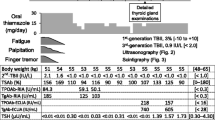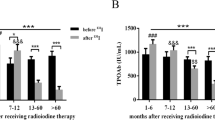Abstract
Background and Aim: In Graves’ hyperthyroidism, suppression of serum TSH after restoration of normal serum T4 and T3 with treatment has been attributed to binding of TSH-receptor antibodies to TSH receptors in the pituitary. Accordingly, the relationship between TSH and serum thyroid stimulating immunoglobulin (TSI) was examined during follow-up of patients with Graves’ hyperthyroidism. Subjects and Methods: 23 patients with Graves’ hyperthyroidism were identified who met the inclusion criteria of at least 24 months follow-up after initiation of methimazole and availability of concurrent measurements of serum TSH and TSI. Results: TSI disappeared in 12 patients (Group A) and persisted in 11 patients (Group B). Initial T4 was not significantly different between the 2 groups. However, TSI was significantly lower in Group A than Group B [median (interquartile range) 179 (152–212)% vs 255 (208–369)%, p=0.0009]. In Group A, TSH normalized during treatment, and this anteceded disappearance of TSI by a significant time interval [median (interquartile range) 6 (3–8) months vs 15 (11–20) months, p=0.005]. In Group B, TSI persisted in all patients during follow-up ranging from 24 to 73 months. No correlation was found to exist between serum TSH and TSI, and for Group B TSI at final follow-up was not significantly different from the initial value [median (interquartile range) 255 (208–369)% vs 236 (160–310)%, p=0.4]. Conclusions: These findings do not support the suggestion that TSI has a direct suppressive effect on TSH secretion.
Similar content being viewed by others
References
Allannic H, Fauchet R, Orgiazzi A, et al. Antithyroid drugs and Graves’ disease: a prospective randomized evaluation of the efficacy of treatment duration. J Clin Endocrinol Metab 1990, 70: 675–9.
Garcia-Mayor RVG, Paramo C, Luna Cano R, et al. Antithyroid drugs and Graves’ hyperthyroidism. Significance of treatment duration and TRAb determination on lasting remission. J Endocrinol Invest 1992, 15: 815–20.
Maugendre D, Gate A, Campion L, et al. Antithyroid drugs and Graves’ disease — prospective randomized assessment of long-term treatment. Clin Endocrinol 1990, 50: 127–32.
Jonas M, Ambroziak U, Bednarczuk T, et al. Predicting a relapse of Graves’ hyperthyroidism in adults during the early phase of treatment with anti-thyroid drugs. Pol J Endocrinol 2006, 6: 596–604.
Cappelli C, Gandossi E, Castellano M, et al. Prognostic value of thyrotropin receptor antibodies (TRAb) in Graves’ disease: a 120 months prospective study. Endocrine J 2007, 54: 713–20.
Kaguelidou F, Alberti C, Castanet M, et al. French Childhood Graves’ Disease Study Group. Predictors of autoimmune hyperthyroidism relapse in children after discontinuation of antithyroid drug treatment. J Clin Endocrinol Metab 2008, 93: 3817–26.
Brokken LJ, Wiersinga WM, Prummel MF. Thyrotropin receptor autoantibodies are associated with continued thyrotropin suppression in treated euthyroid Graves’ disease patients. J Clin Endocrinol Metab 2003, 88: 4135–8.
Chung YJ, Lee BW, Kim JY. Continued suppression of serum TSH level may be attributed to TSH receptor antibody activity as well as the time to recovery of thyroid hormone in treated euthyroid Graves’ patients. Thyroid 2006, 16: 1251–7.
Kabadi UM, Premachandra BN. Serum thyrotropin in Graves’ disease: a more reliable index of circulating thyroid-stimulating immunoglobulin level than thyroid function. Endocr Pract 2007, 13: 615–9.
Author information
Authors and Affiliations
Corresponding author
Rights and permissions
About this article
Cite this article
Woeber, K.A. Relationship between thyroid stimulating hormone and thyroid stimulating immunoglobulin in Graves’ hyperthyroidism. J Endocrinol Invest 34, 222–224 (2011). https://doi.org/10.1007/BF03347070
Accepted:
Published:
Issue Date:
DOI: https://doi.org/10.1007/BF03347070




